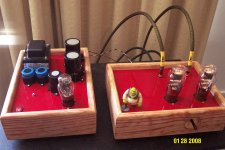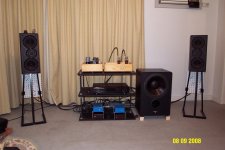I wanted to build my preamp in one chassis only, but disregarding hum, the size and weight of it all was just too much. You need room to change parts and tweak the sound. I would say 2 chassis minimum or 3 smaller ones for signal, HT supply and Filament supply. You will not regret it if it is your first build. Trust me.
I have always been using two....one for AC and one for DC....mainly to isolate the vibrations of the transformers and the caps.......
I mean two chassis inside, but looks like one chassis outside.....getting rid of all those plugs and solder joints....
I have always been using two....one for AC and one for DC....mainly to isolate the vibrations of the transformers and the caps.......
When you say AC do you mean just the power transformers and nothing else in one chassis? Please upload pictures. Always something to learn.
I mean two chassis inside, but looks like one chassis outside.....getting rid of all those plugs and solder joints....
Short paths has many advantages of course, but you have to be very clever with positioning and shielding to avoid electromagnetic fields from the mains transformers and the raw DC current pulsing of the filament supplies.
The chassis on the left houses all the AC parts, including the parts for filaments bias, with raw DC going to the amp chassis.
I have tried soldering the umbilical on both side, but that would make moving the two chassis a bit awkward; now it is only soldered on the AC side, with a plug on the amp chassis side.
I have tried soldering the umbilical on both side, but that would make moving the two chassis a bit awkward; now it is only soldered on the AC side, with a plug on the amp chassis side.
Attachments
I have tried soldering the umbilical on both sides, but that would make moving the two chassis a bit awkward; now it is only soldered on the AC chassis side, with a plug on the amp chassis side.
The chassis on the left houses all the AC parts, including the parts for filaments bias, with raw DC going to the amp chassis.
I have tried soldering the umbilical on both side, but that would make moving the two chassis a bit awkward; now it is only soldered on the AC side, with a plug on the amp chassis side.
Ok, then I understand.
Nice looking "Shrek" amp by the way. I like the red colour.
Do you see the blue and black boxes at the bottom??
They are my pair of T amp "mono" block.
The AC parts are in the black sealing boxes while the T amps are in the blue boxes.
They are my pair of T amp "mono" block.
The AC parts are in the black sealing boxes while the T amps are in the blue boxes.
I see them. How unconventional! Directly heated preamp and class D power amps. It seems that you aren't afraid of doing things your own way. Well done!Do you see the blue and black boxes at the bottom??
They are my pair of T amp "mono" block.
The AC parts are in the black sealing boxes while the T amps are in the blue boxes.
I was using modified Luxman tube power amp before until I put the T amp on line between my 10 line (now I have a 26 line amp as well) and my ME-2........that was in 2008-ish......the sub is gone (no need).....and I am building a new power supply for my T amp.....
DHT line amps are indeed something special. How would you describe the sound differences between your 10 and 26 amps?
If I am going to listen mostly to female vocal for that session, I will use my VT-25A.....anyother time, I will enjoy the music all the same and no need to find the difference.
20 ga. Teflon wire can be had for 0.10 foot and is silver braided conductors.
it is very heat resistant and will solder more easily. why on earth would you spend 44 a foot when you can have a roll for $15. spend it on a DC power supply for the 26 heater
it is very heat resistant and will solder more easily. why on earth would you spend 44 a foot when you can have a roll for $15. spend it on a DC power supply for the 26 heater
Do I need to connect that copper braid sleeve to earth to be effective please???
- Home
- Amplifiers
- Tubes / Valves
- #26 pre amp

